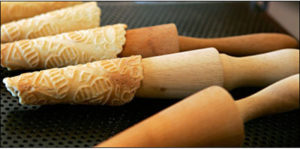 The kids are back in school; the State Fair is over; the sweatshirts are at the ready — and that means baking season is upon us.
The kids are back in school; the State Fair is over; the sweatshirts are at the ready — and that means baking season is upon us.

KRUMKAKE
Krumkake (pronounced KROOM-ka-ka) means “bent cake” in Norwegian. Most people see it more as a cookie than a cake but everyone who tries it likes. Krumkake is a Norwegian waffle cookie. The batter recipe varies but it is basically made of flour, butter, eggs, sugar, and cream and cooked on a decorative two-sided iron. Once hot, the krumkake are rolled into small cones around a wooden cone form. Krumkake can be eaten plain or filled with whipped cream or other fillings.

The krumkake iron was the first consumer product manufactured by Nordic Ware in 1948. The krumkake iron sold well due in part to Minnesota’s large Scandinavian population.
An article in Norwegian American discussed the krumkake the 1000 year old cookie and it’s traditions:
Krumkaker, as well as goro (another old classic cookie in Norway) are variations of waffles, and are known for their very ornate and pretty patterns due to the special irons they are baked in. Each iron can have a different pattern based on where in Norway you are and what traditions each family has, and they can be old fashioned (many Norwegian families have had them in their family for generations) or more modern in style.
While making your krumkake you can sing the Krumkake Polka:
Ingebretsen’s is the place for all your krumkake supplies (even the ingredients). Check them all out here.
 KRANSEKAKE
KRANSEKAKE
The kransekake (literally wreath cake) is a traditional Danish and Norwegian confection, usually eaten on special occasions such as weddings, baptisms, Christmas, or New Year’s Eve.
Kransekake are a series of concentric rings of cake, layered on top of each other in order to form a steep-sloped cone shape—often 18 or more layers—stuck together with white icing. They are not easy to make and so it is understandable why they are served at “special” occasions.
 The kransekake cake layers are made with almonds, sugar, and egg whites. The ideal kransekake is hard to the touch, yet soft and chewy.
The kransekake cake layers are made with almonds, sugar, and egg whites. The ideal kransekake is hard to the touch, yet soft and chewy.
The original variant used at weddings is called overflødighedshorn (horn of plenty) and is shaped like a cornucopia and filled with chocolates, cookies, and other small treats. Sometimes a bottle of wine or aquavit is placed in the center, and the cake is decorated with ornaments such as flags.
The origin of the Kransekage can be traced to the 18th century, where it was first created by a baker in Copenhagen.
Whether you want to make your own kransekake or buy delicious kransekake bars, Ingebretsen’s has the the items you need.